“It’s Like Having an Uncontrolled Situation”: Using Body Maps to Understand the Embodied Experiences of People with Hidradenitis Suppurativa, a Chronic Dermatological Condition
Abstract
1. Introduction
Then I let go of the shame, knowing I was not to blame. It did, it did have a name. It was, it is, HS that caused such great pain.—Denise (cisgender woman, White/Native American, USA)
1.1. Background
1.1.1. Hidradenitis Suppurativa
1.1.2. COVID-19 and HS
1.1.3. Theoretical Frameworks
1.1.4. Visual Methodology in Qualitative Research
Drawings
1.1.5. Body Maps
2. Materials and Methods
2.1. Qualitative Analysis
2.2. Interview Analysis
2.3. Body Map Analysis
3. Results
3.1. Participant Demographics
3.2. Body Map Colors
This was something that was an issue over the years. So “tears I’ve cried” because of shame until I learned what caused my pain. …And I did a lot of sweating and I’ve spent a lot of time crying. And so I put the tears, and the puddles on the floor. Because, you know, you’re crying because there just wasn’t awareness. When I was younger, I felt such shame and I felt like I had to hide things, and so I remember going through that.
3.3. Body Mapping Images
3.4. Words on Body Maps
3.5. Body Maps as Medical Drawings
3.6. Participant Reflections on Body Mapping Process
I’m gonna share this with my wife and show, you know, show her as well. Even though she understands and sees [the HS] I feel like she doesn’t always understand, so visually I think this would help her get it, you know, so yeah…. It’s been, it’s been a very good learning and therapeutic experience.
And what really helped me was trying to get the story back. To really try to find, uh, I think storytelling really works for me, you know, so uh like trying to see what has been happening, and how can I tell this story with the body map. So I finally got something for me and just kept everyone away, and just took my colors and starting. And yeah, then it was easy. No, but I think many ideas have been working inside of me for a couple days.
I don’t know that I’ve ever thought about the process… I live the process, I’m busy. I just, you know, I just plug along, plug along, plug along. So taking a moment just to sit and think about it. I think it’s probably the first time that I’ve said, like you know what actually I’ve come a long way with this. Uhm. And it’s so easy if I talk about it, if I bring it up or if I’m you know, engaging with somebody about it for first time. Because the initial emotions I felt when… I had my first flare are still so visceral to me. That’s easily what I described, right. I don’t describe where I am now, I describe the first flare. The confusion, the fear. So it was nice to like to honor that. And say that’s a part of my journey and is not, should not be minimized. But I’m also in a different place now and I don’t know that I’ve ever taken the time to see the journey.
I was like, it was a little strange to put it on paper cause like for once someone was actually asking me about it and that was kind of weird because no one ever asks. No one really wants to talk about abscesses on your skin. You know it kind of makes you sound like a leper, you know. I thought it was kind of empowering to fill this out. I was excited.
4. Discussion
5. Conclusions
Author Contributions
Funding
Institutional Review Board Statement
Informed Consent Statement
Data Availability Statement
Acknowledgments
Conflicts of Interest
References
- Alikhan, Ali, Peter J. Lynch, and Daniel B. Eisen. 2009. Hidradenitis Suppurativa: A Comprehensive Review. Journal of the American Academy of Dermatology 60: 539–61. [Google Scholar] [CrossRef] [PubMed]
- Al-Muhandis, Khalid. 2024. An Exploration of Life with a Chronic Skin Condition. Doctoral dissertation, Royal Holloway, University of London, London, UK. Available online: https://pure.royalholloway.ac.uk/ws/files/58885107/Khalid_Al-Muhandis_PhD_thesis_An_exploration_of_life_with_a_chronic_skin_condition.pdf (accessed on 28 February 2024).
- Aparício Martins, Inês, Beatriz Figueira Vilela, and Joana Cabete. 2023. Diagnostic Delay in Hidradenitis Suppurativa: Still an Unsolved Problem. Skin Appendage Disorders, 1–4. [Google Scholar] [CrossRef]
- Ballard, Kimberly, and Victoria L. Shuman. 2024. Hidradenitis Suppurativa. In StatPearls. Treasure Island: StatPearls Publishing. [Google Scholar]
- Boydell, Katherine M., Jill Bennett, Angela Dew, Julia Lappin, Caroline Lenette, Jane Ussher, Priya Vaughan, and Ruth Wells. 2020. Women and Stigma: A Protocol for Understanding Intersections of Experience through Body Mapping. International Journal of Environmental Research and Public Health 17: 5432. [Google Scholar] [CrossRef] [PubMed]
- Boydell, Kathy. 2021. Applying Body Mapping in Research: An Arts-Based Method, 1st ed. New York: Routledge. [Google Scholar]
- Brailas, Alexios. 2020. Using Drawings in Qualitative Interviews: An Introduction to the Practice. The Qualitative Report 25: 4447–60. [Google Scholar] [CrossRef]
- Bury, Michael. 1982. Chronic Illness as Biographical Disruption. Sociology of Health & Illness 4: 167–82. [Google Scholar] [CrossRef]
- Charmaz, Kathy. 1983. Loss of Self: A Fundamental Form of Suffering in the Chronically Ill. Sociology of Health & Illness 5: 168–95. [Google Scholar] [CrossRef]
- Charmaz, Kathy. 1991. Good Days, Bad Days: The Self and Chronic Illness in Time. New Jersey: Rutgers University Press. [Google Scholar]
- Coetzee, Bronwyne, Rizwana Roomaney, Nicola Willis, and Ashraf Kagee. 2019. Body Mapping in Research. In Handbook of Research Methods in Health Social Sciences. Edited by Pranee Liamputtong. Singapore: Springer, pp. 1237–54. [Google Scholar] [CrossRef]
- Collier, Erin K., Jennifer L. Hsiao, Vivian Y. Shi, and Haley B. Naik. 2020. Comprehensive Approach to Managing Hidradenitis Suppurativa Patients. International Journal of Dermatology 59: 744–47. [Google Scholar] [CrossRef]
- Cross, Katherine, Allison Kabel, and Cathy Lysack. 2006. Images of Self and Spinal Cord Injury: Exploring Drawing as a Visual Method in Disability Research. Visual Studies 21: 183–93. [Google Scholar] [CrossRef]
- De Jager, Adèle, Anna Tewson, Bryn Ludlow, and Katherine Boydell. 2016. Embodied Ways of Storying the Self: A Systematic Review of Body-Mapping. Forum Qualitative Sozialforschung/Forum: Qualitative Social Research 17: 2526. [Google Scholar] [CrossRef]
- de Souza, Jacqueline, Carla Aparecida Arena Ventura, Jordana Luiza Gouvêa de Oliveira, Loraine Vivian Gaino, Juliana Cristina dos Santos Monteiro, Jaqueline Lemos de Oliveira, Leticia Yamawaka de Almeida, Solina Richter, and Denise Saint-Arnault. 2021. Experience of Vulnerable Women Narrated through the Body-Mapping Technique. International Journal of Environmental Research and Public Health 18: 13094. [Google Scholar] [CrossRef] [PubMed]
- DeVault, Marjorie L., and Glenda Gross. 2012. Handbook of Feminist Research: Theory and Praxis. Thousand Oaks: SAGE Publications, Inc. [Google Scholar] [CrossRef]
- Dovalovsky, Katrina, Carolina Puyana, and Maria M. Tsoukas. 2023. Hidradenitis Suppurativa Perspectives during the COVID-19 Pandemic. Clinics in Dermatology 41: 622–27. [Google Scholar] [CrossRef]
- Editorial Team HS Disease.com. 2020. Common Misdiagnoses of Hidradenitis Suppurativa. HSDisease.Com, September 2. Available online: https://hsdisease.com/misdiagnosis (accessed on 2 February 2024).
- Esme, Pelin, Gulsen Akoglu, Oktay Sari, and Ercan Caliskan. 2021. Family Physicians’ Awareness and General Knowledge of Hidradenitis Suppurativa: A Survey Research. International Journal of Clinical Practice 75: 14186. [Google Scholar] [CrossRef]
- Garg, Amit, Joslyn S. Kirby, Jonathan Lavian, Gloria Lin, and Andrew Strunk. 2017. Sex- and Age-Adjusted Population Analysis of Prevalence Estimates for Hidradenitis Suppurativa in the United States. JAMA Dermatology 153: 760. [Google Scholar] [CrossRef]
- Gastaldo, Denise, Natalia Rivas-Quarneti, and Lilian Magalhaes. 2018. Body-Map Storytelling as a Health Research Methodology: Blurred Lines Creating Clear Pictures. Forum Qualitative Sozialforschung/Forum: Qualitative Social Research 19: 2858. [Google Scholar] [CrossRef]
- Guillemin, Marilys. 2004. Understanding Illness: Using Drawings as a Research Method. Qualitative Health Research 14: 272–89. [Google Scholar] [CrossRef]
- Guillemin, Marilys, and Sarah Drew. 2010. Questions of Process in Participant-Generated Visual Methodologies. Visual Studies 25: 175–88. [Google Scholar] [CrossRef]
- Henderson, Helen, Alexandrina Marques da Silva, Mariano da Silva, Helio Afranio Soares Xavier, Silvina Amaral Mendonca, Rui Maria de Araújo, Cathy Vaughan, and Meghan A. Bohren. 2023. Body mapping as a participatory method to explore health provider beliefs and understanding about sexual and reproductive health and rights in Timor-Leste. SSM—Qualitative Research in Health 3: 100205. [Google Scholar] [CrossRef]
- Howells, Laura, Nicholas Lancaster, Megan McPhee, Christine Bundy, John R. Ingram, Paul Leighton, Kate Henaghan-Sykes, and Kim S. Thomas. 2021. Thematic Synthesis of the Experiences of People with Hidradenitis Suppurativa: A Systematic Review. British Journal of Dermatology 185: 921–34. [Google Scholar] [CrossRef] [PubMed]
- Ingraham, Natalie, Lena R. Hann, J. Austin Williamson, and Caleb Drew. 2022. Communicating with Health Providers and Romantic Partners: The Impact of Negative Emotions on Quality of Life for Individuals with Hidradenitis Suppurativa. International Journal of Women’s Dermatology 8: e049. [Google Scholar] [CrossRef] [PubMed]
- Jeske, Melanie, Jennifer James, and Kelly Joyce. 2023. Diagnosis and the Practices of Patienthood: How Diagnostic Journeys Shape Illness Experiences. Sociology of Health & Illness, 1–17. [Google Scholar] [CrossRef]
- Jobling, Ray. 1988. The Experience of Psoriasis under Treatment. In Living with Chronic Illness: The Experience of Patients and Their Families. Edited by Robert Anderson and Michael Bury. London: Unwin Hyman, pp. 225–45. [Google Scholar]
- Jokela-Pansini, Maaret. 2021. Body Mapping as a Feminist Visual Method: Exploring the Field Through the Body. In Raum und Bild—Strategien Visueller Raumbezogener Forschung. Edited by Raphaela Kogler and Jeannine Wintzer. Berlin and Heidelberg: Springer, pp. 69–82. [Google Scholar] [CrossRef]
- Kilgour, James M., Shufeng Li, and Kavita Y. Sarin. 2021. Hidradenitis Suppurativa in Patients of Color Is Associated with Increased Disease Severity and Healthcare Utilization: A Retrospective Analysis of 2 U.S. Cohorts. JAAD International 3: 42–52. [Google Scholar] [CrossRef]
- Kimball, Alexa B., Joslyn Kirby, John R. Ingram, Tanja Tran, Ingrid Pansar, Valerie Ciaravino, Damon Willems, Anne-Mary Lewis-Mikhael, Vanita Tongbram, and Amit Garg. 2024. Burden of Hidradenitis Suppurativa: A Systematic Literature Review of Patient Reported Outcomes. Dermatology and Therapy 14: 83–98. [Google Scholar] [CrossRef]
- Lee, Erika Yue, Raed Alhusayen, Perla Lansang, Neil Shear, and Jensen Yeung. 2017. What Is Hidradenitis Suppurativa? Canadian Family Physician Medecin De Famille Canadien 63: 114–20. [Google Scholar]
- Le Henaff, Yannick, and Stéphane Heas. 2023. Gender and Care in the Context of Rare Diseases: Exploring Nuances of Emotional Support and the Division of Household Labor. Health Sociology Review 32: 357–71. [Google Scholar] [CrossRef]
- Ludlow, Bryn A. 2014. Witnessing: Creating Visual Research Memos About Patient Experiences of Body Mapping in a Dialysis Unit. American Journal of Kidney Diseases 64: A13–14. [Google Scholar] [CrossRef] [PubMed]
- Macklis, Paul C., Kelly Tyler, Jessica Kaffenberger, Shawn Kwatra, and Benjamin H. Kaffenberger. 2022. Lifestyle Modifications Associated with Symptom Improvement in Hidradenitis Suppurativa Patients. Archives of Dermatological Research 314: 293–300. [Google Scholar] [CrossRef] [PubMed]
- Margesson, Lynette J., and F. William Danby. 2014. Hidradenitis Suppurativa. Best Practice & Research Clinical Obstetrics & Gynaecology 28: 1013–27. [Google Scholar] [CrossRef]
- Matusiak, Ł. 2020. Profound Consequences of Hidradenitis Suppurativa: A Review. British Journal of Dermatology 183: e171–77. [Google Scholar] [CrossRef] [PubMed]
- Mayra, Kaveri, Jane Sandall, Zoë Matthews, and Sabu S. Padmadas. 2022. Breaking the Silence about Obstetric Violence: Body Mapping Women’s Narratives of Respect, Disrespect and Abuse during Childbirth in Bihar, India. BMC Pregnancy and Childbirth 22: 318. [Google Scholar] [CrossRef] [PubMed]
- Murray, Aisling, Mariana Steffen, Eleanor Keiller, Maria Grazia Turri, and Jennifer Y. F. Lau. 2023. Body Mapping for Arts-Based Inquiry in Mental Health Research: A Scoping Review. The Lancet Psychiatry 10: 896–908. [Google Scholar] [CrossRef] [PubMed]
- Nesher Shoshan, Hadar, and Wilken Wehrt. 2022. Understanding ‘Zoom Fatigue’: A Mixed-Method Approach. Applied Psychology 71: 827–52. [Google Scholar] [CrossRef]
- Patel, Kevin R., Harrison H. Lee, Supriya Rastogi, Paras P. Vakharia, Tammy Hua, Krishan Chhiba, Vivek Singam, and Jonathan I. Silverberg. 2020. Association between Hidradenitis Suppurativa, Depression, Anxiety, and Suicidality: A Systematic Review and Meta-Analysis. Journal of the American Academy of Dermatology 83: 737–44. [Google Scholar] [CrossRef]
- Patel, Zarine S., Lauren K. Hoffman, Dawn C. Buse, Amy S. Grinberg, Ladan Afifi, Steven R. Cohen, Michelle A. Lowes, and Elizabeth K. Seng. 2017. Pain, Psychological Comorbidities, Disability, and Impaired Qualify of Life in Hidradenitis Suppurativa. Current Pain and Headache Reports 21: 49. [Google Scholar] [CrossRef]
- Phillips, Joanna, Jane Ogden, and Claire Copland. 2015. Using Drawings of Pain-Related Images to Understand the Experience of Chronic Pain: A Qualitative Study. British Journal of Occupational Therapy 78: 404–11. [Google Scholar] [CrossRef]
- Richardson, Jane C., Bie Nio Ong, and Julius Sim. 2007. Experiencing Chronic Widespread Pain in a Family Context: Giving and Receiving Practical and Emotional Support. Sociology of Health & Illness 29: 347–65. [Google Scholar] [CrossRef]
- Sabat, Robert, Gregor B. E. Jemec, Łukasz Matusiak, Alexa B. Kimball, Errol Prens, and Kerstin Wolk. 2020. Hidradenitis Suppurativa. Nature Reviews Disease Primers 6: 18. [Google Scholar] [CrossRef] [PubMed]
- Santarossa, Sara, Ashley Redding, and Dana Murphy. 2023. Pioneering Virtual Body Mapping: A Methodological Guide for Researchers Using a Health-Affected Population as an Example. American Journal of Qualitative Research 7: 73–88. [Google Scholar] [CrossRef]
- Schukow, Casey, Clare Townsend, Nicole Jess, and Steven Daveluy. 2023. Identifying Barriers to Developing Expertise in Hidradenitis Suppurativa. The Journal of Clinical and Aesthetic Dermatology 16: 38–40. [Google Scholar] [PubMed]
- Tarr, Jen, and Helen Thomas. 2011. Mapping Embodiment: Methodologies for Representing Pain and Injury. Qualitative Research 11: 141–57. [Google Scholar] [CrossRef]
- Tzellos, Thrasivoulous, Hongbo Yang, Fan Mu, Brian Calimlim, and James Signorovitch. 2019. Impact of Hidradenitis Suppurativa on Work Loss, Indirect Costs and Income. British Journal of Dermatology 181: 147–54. [Google Scholar] [CrossRef] [PubMed]
- van der Zee, Hessel H., and Gregor B. E. Jemec. 2015. New Insights into the Diagnosis of Hidradenitis Suppurativa: Clinical Presentations and Phenotypes. Journal of the American Academy of Dermatology 73: S23–26. [Google Scholar] [CrossRef] [PubMed]
- Van Schelven, Femke, Eline Van Der Meulen, Elise Wessels, and Hennie R. Boeije. 2023. Let Us Talk Treatment: Using a Digital Body Map Tool to Examine Treatment Burden and Coping Strategies Among Young People with a Chronic Condition. Patient Preference and Adherence 17: 517–29. [Google Scholar] [CrossRef]
- van Straalen, Kelsey R., Sylke Schneider-Burrus, and Errol P. Prens. 2020. Current and Future Treatment of Hidradenitis Suppurativa. British Journal of Dermatology 183: e178–87. [Google Scholar] [CrossRef]
- Vaughan, Priya, Angela Dew, Akii Ngo, Alise Blayney, and Katherine Boydell. 2022. Exploring Embodied Experience via Videoconferencing: A Method for Body Mapping Online. International Journal of Qualitative Methods 21: 160940692211458. [Google Scholar] [CrossRef] [PubMed]
- Yesantharao, Lekha V., Rachana Suresh, Sheera F. Lerman, Carrie Cox, and Julie Caffrey. 2023. Hidradenitis Suppurativa Reddit Support Group: Finding New Meaning in Social Media During the COVID-19 Pandemic. Journal of Burn Care & Research 44: 373–80. [Google Scholar] [CrossRef]
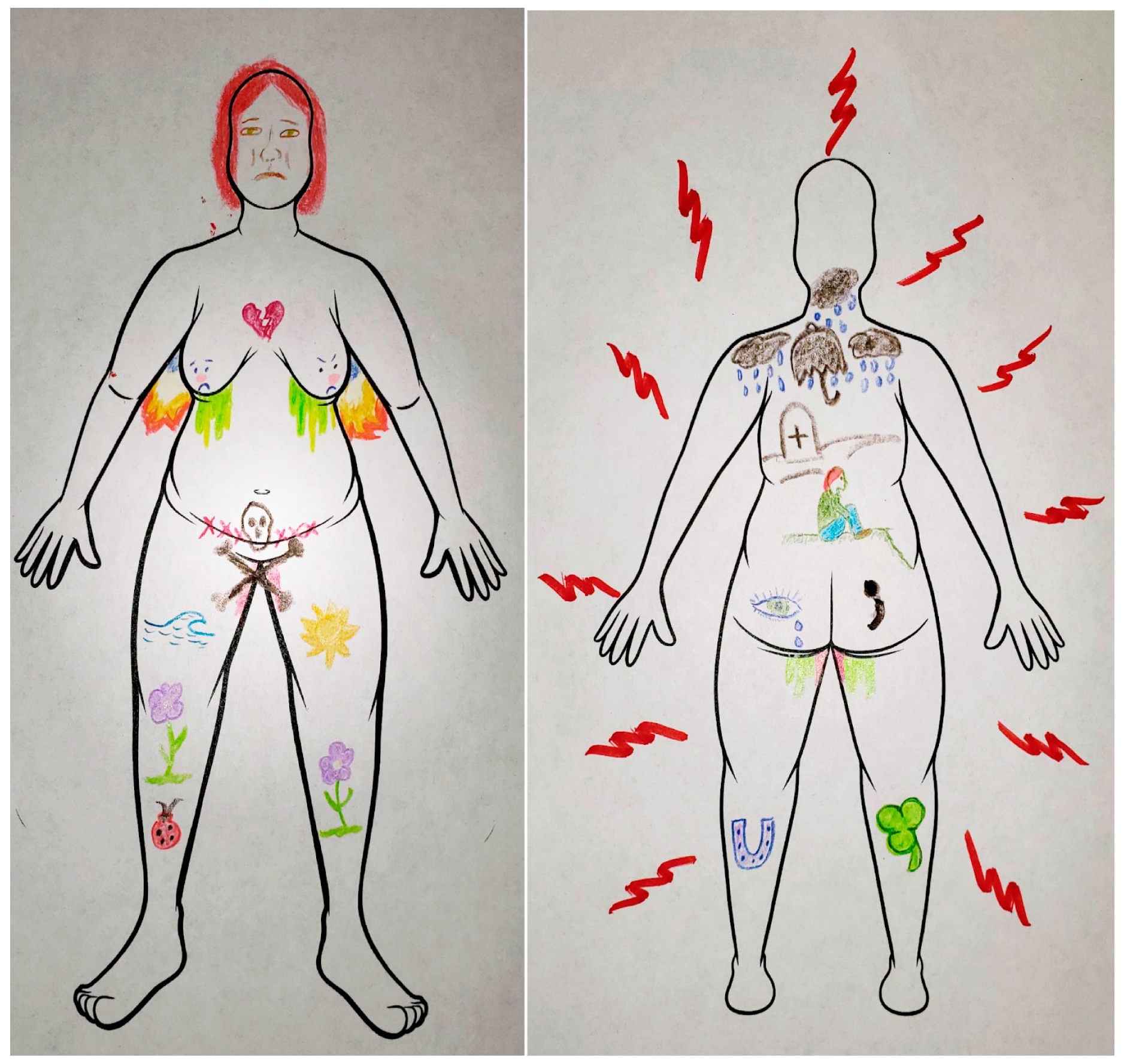
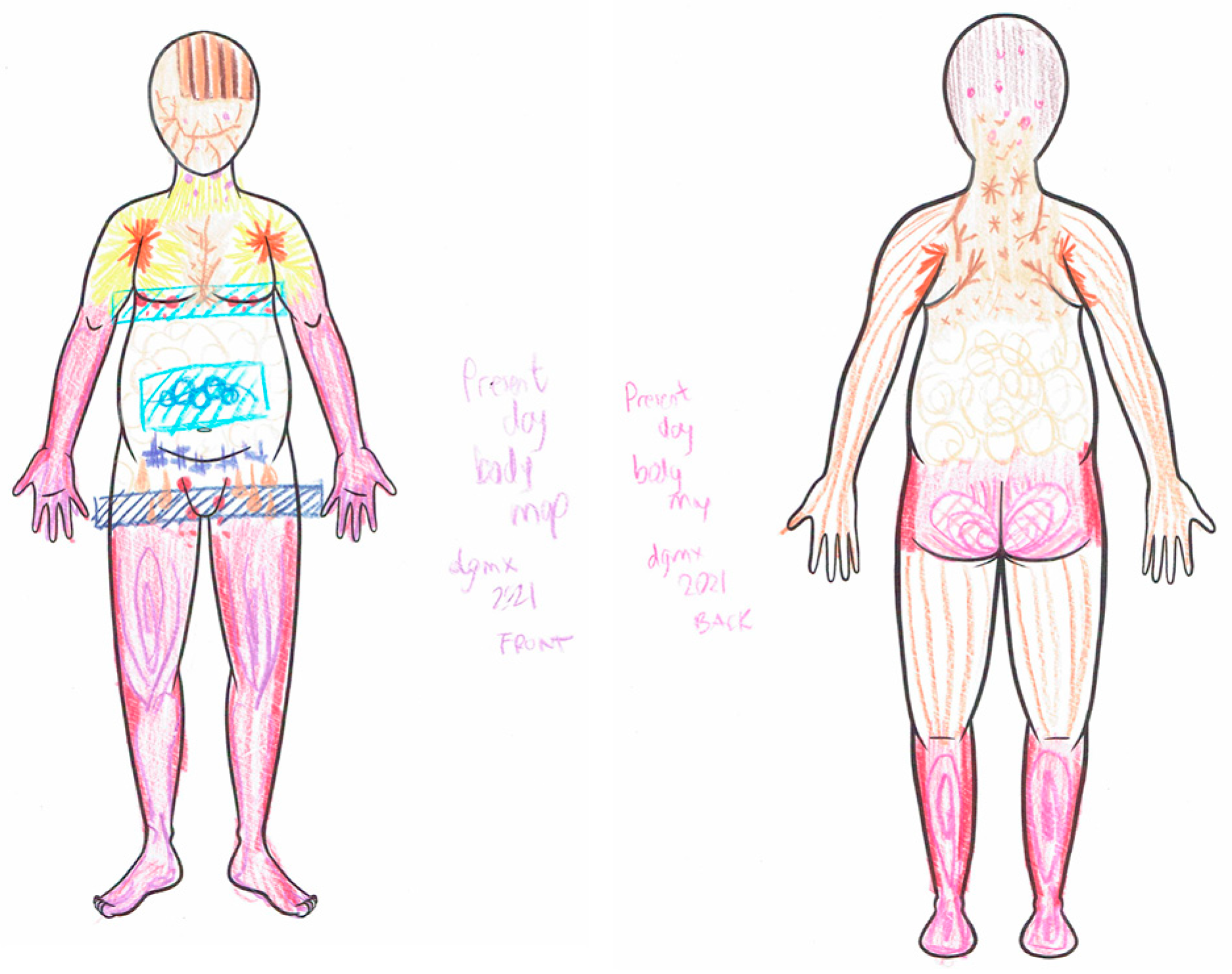
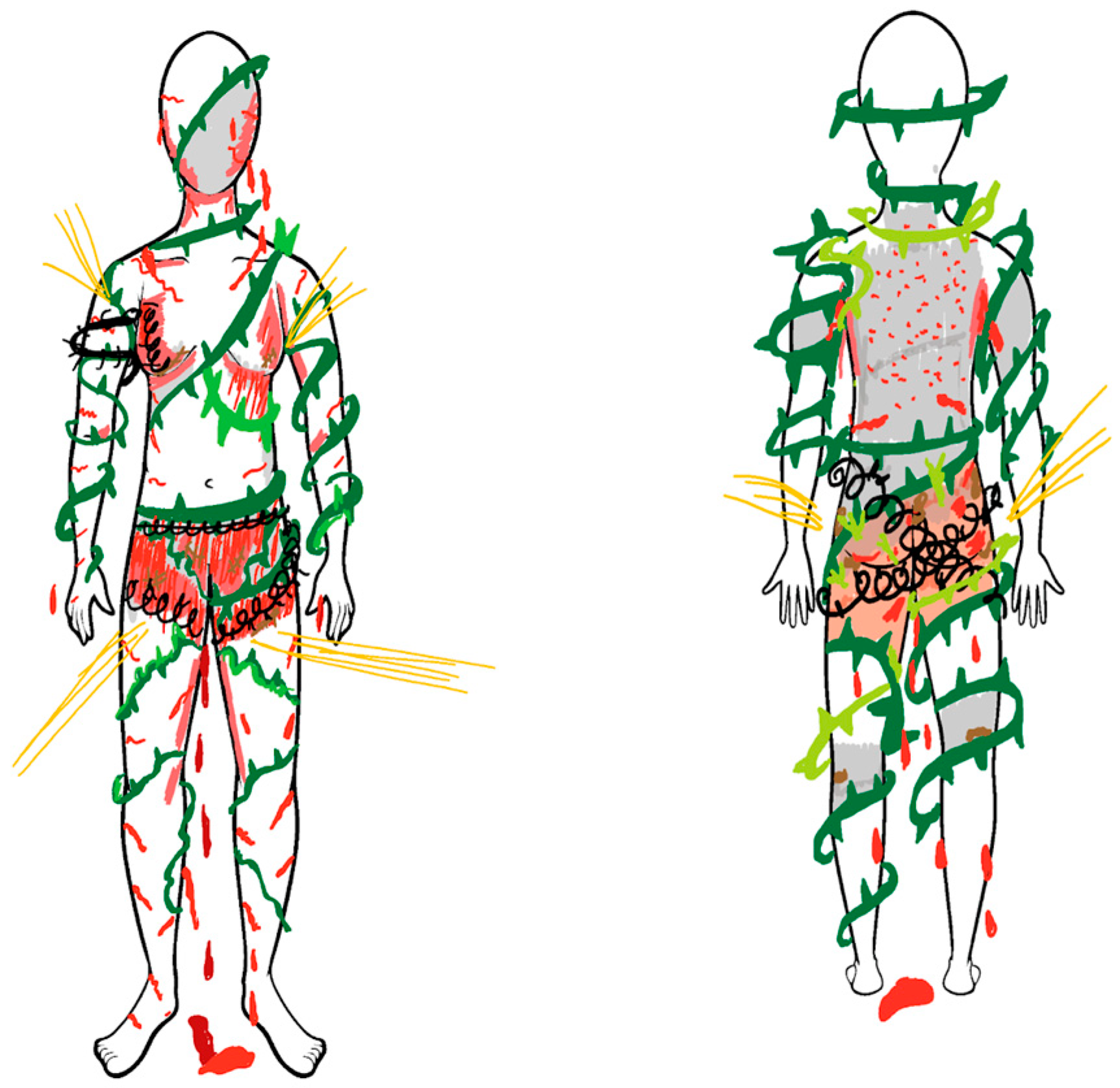
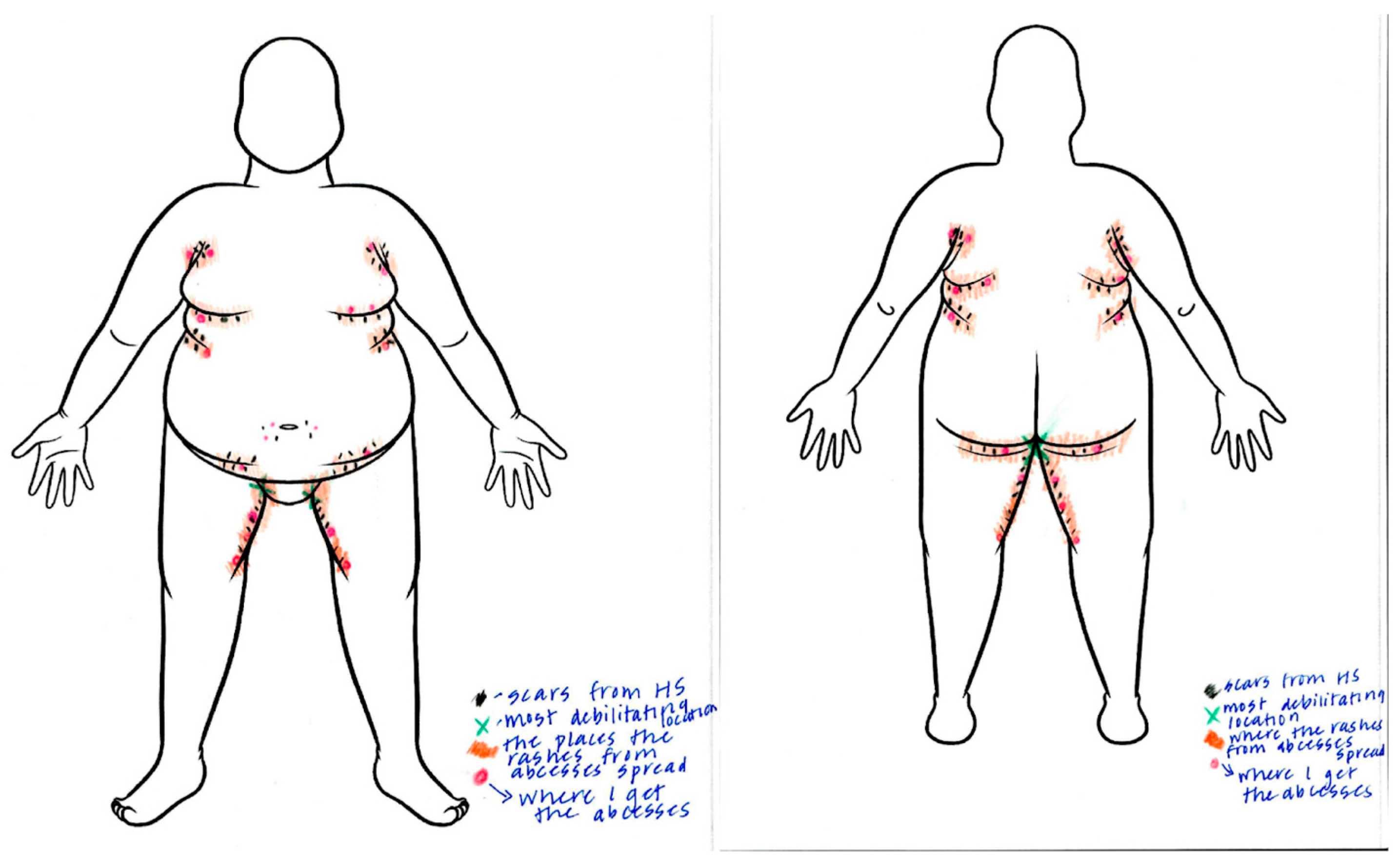
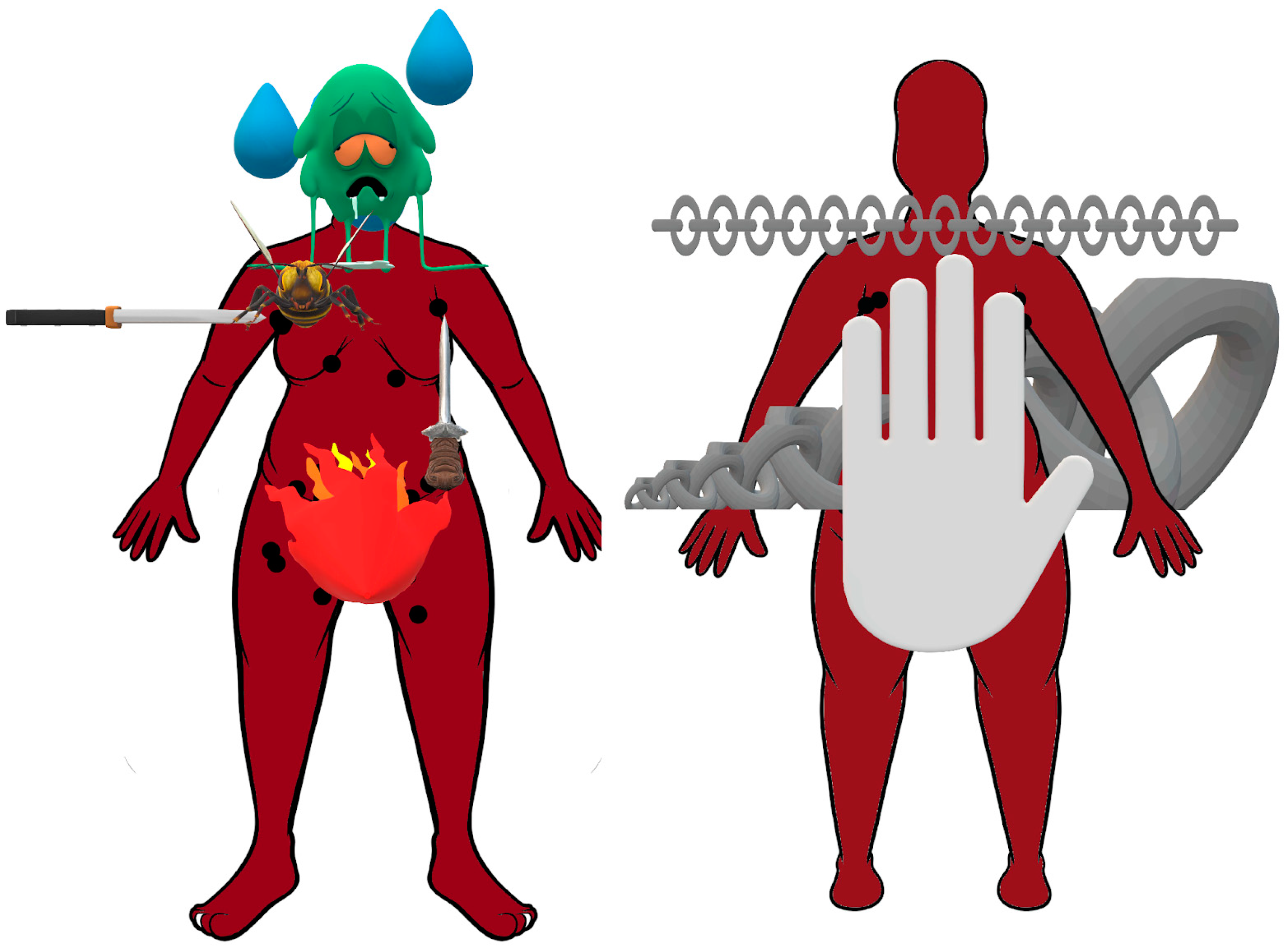
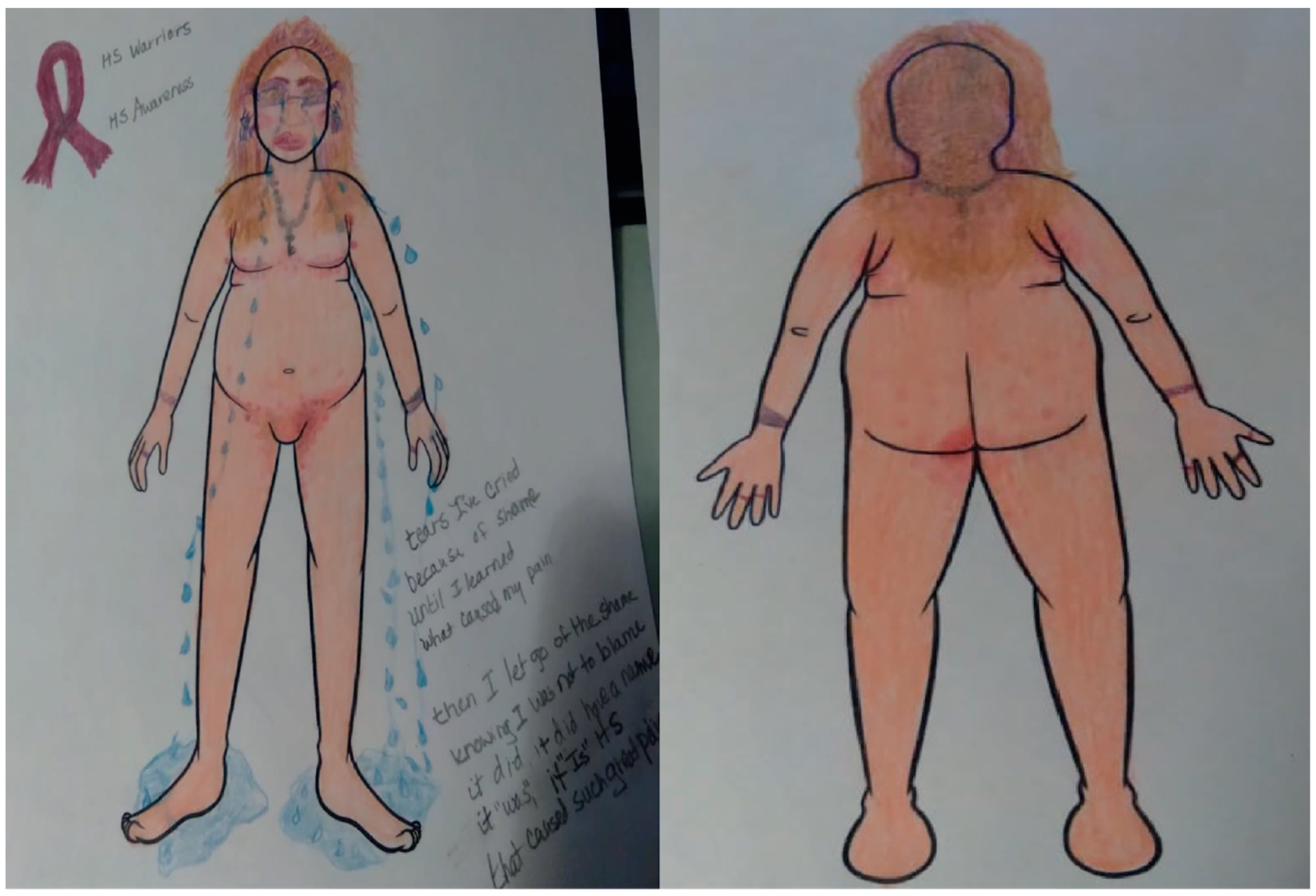
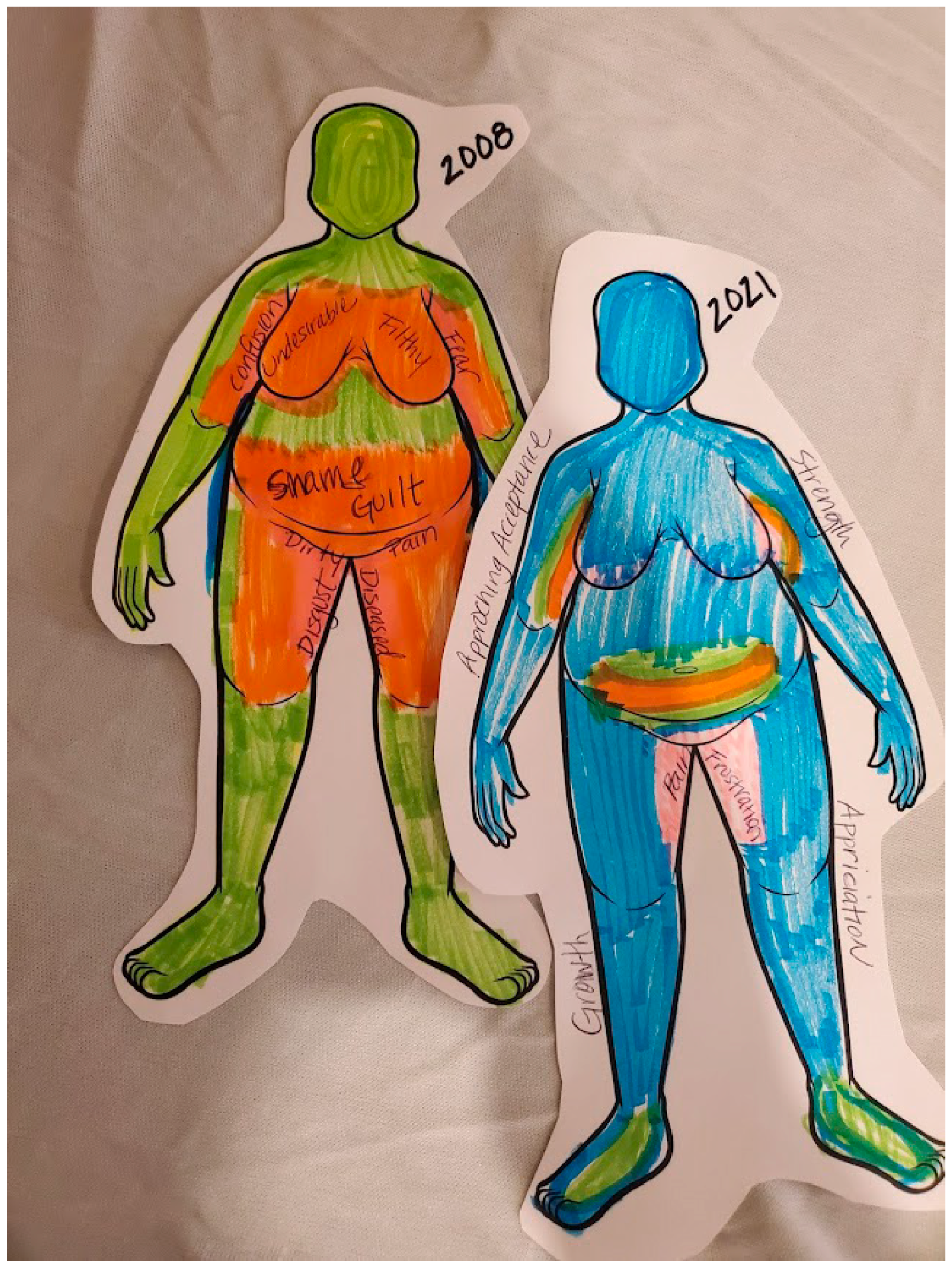
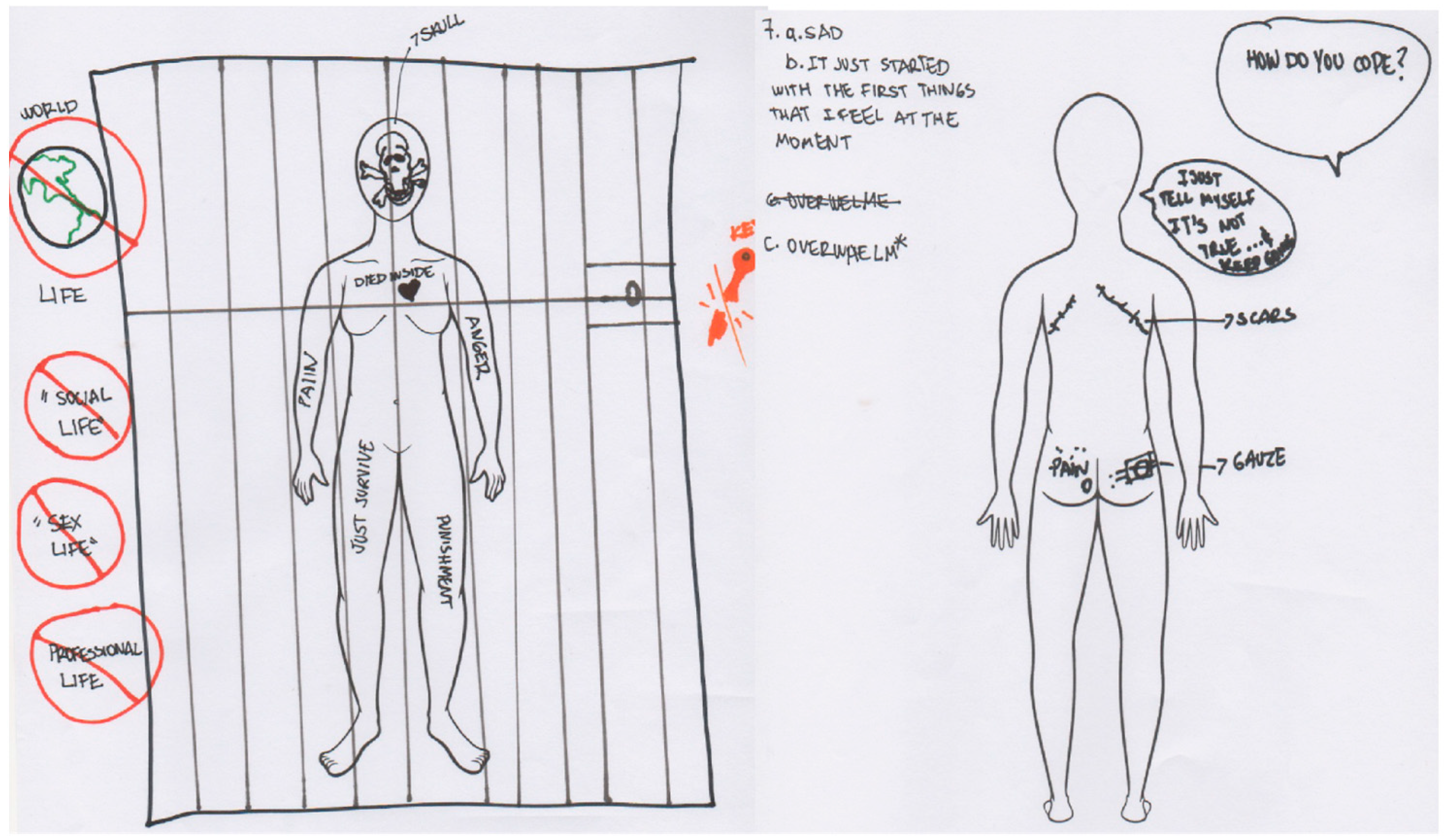

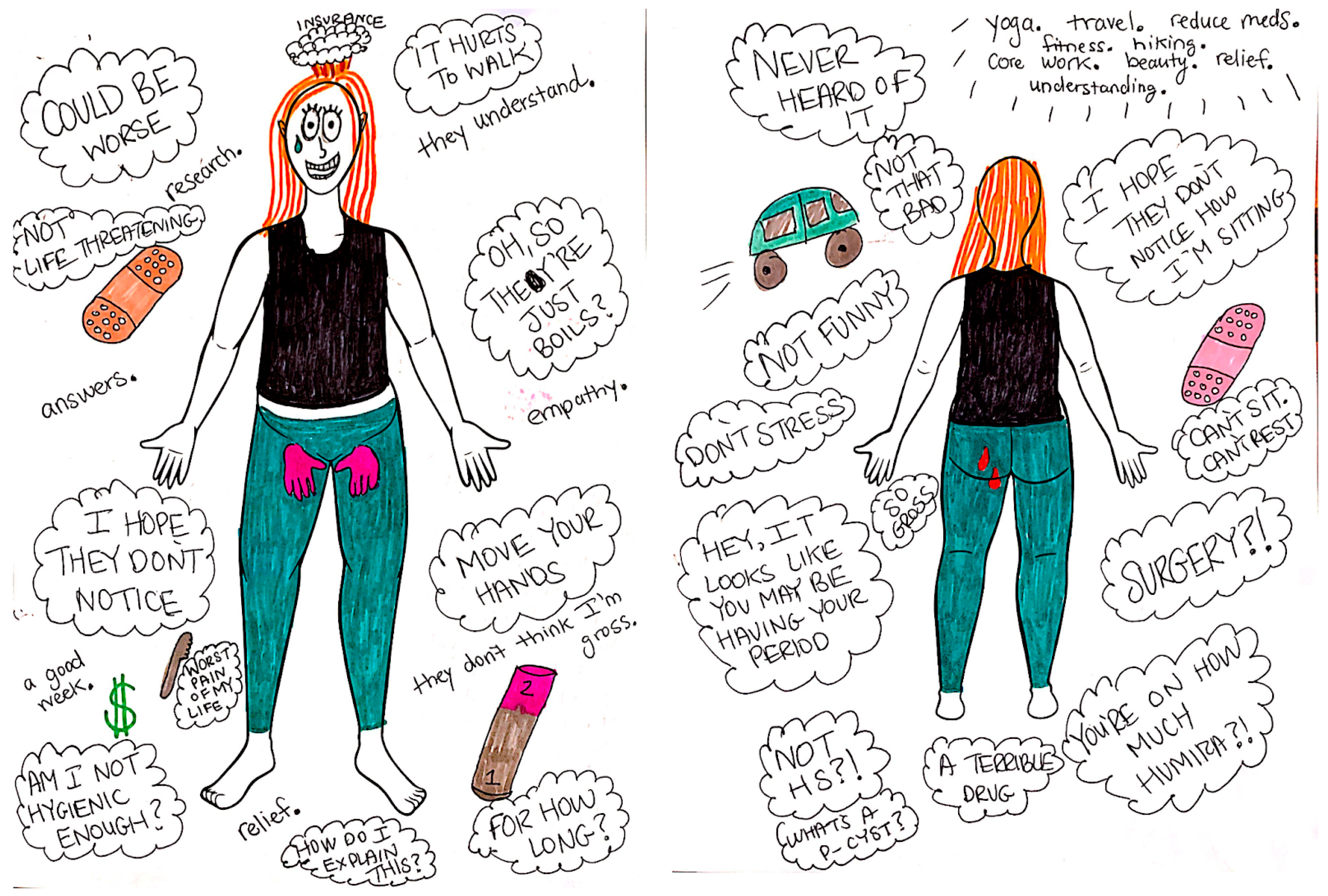
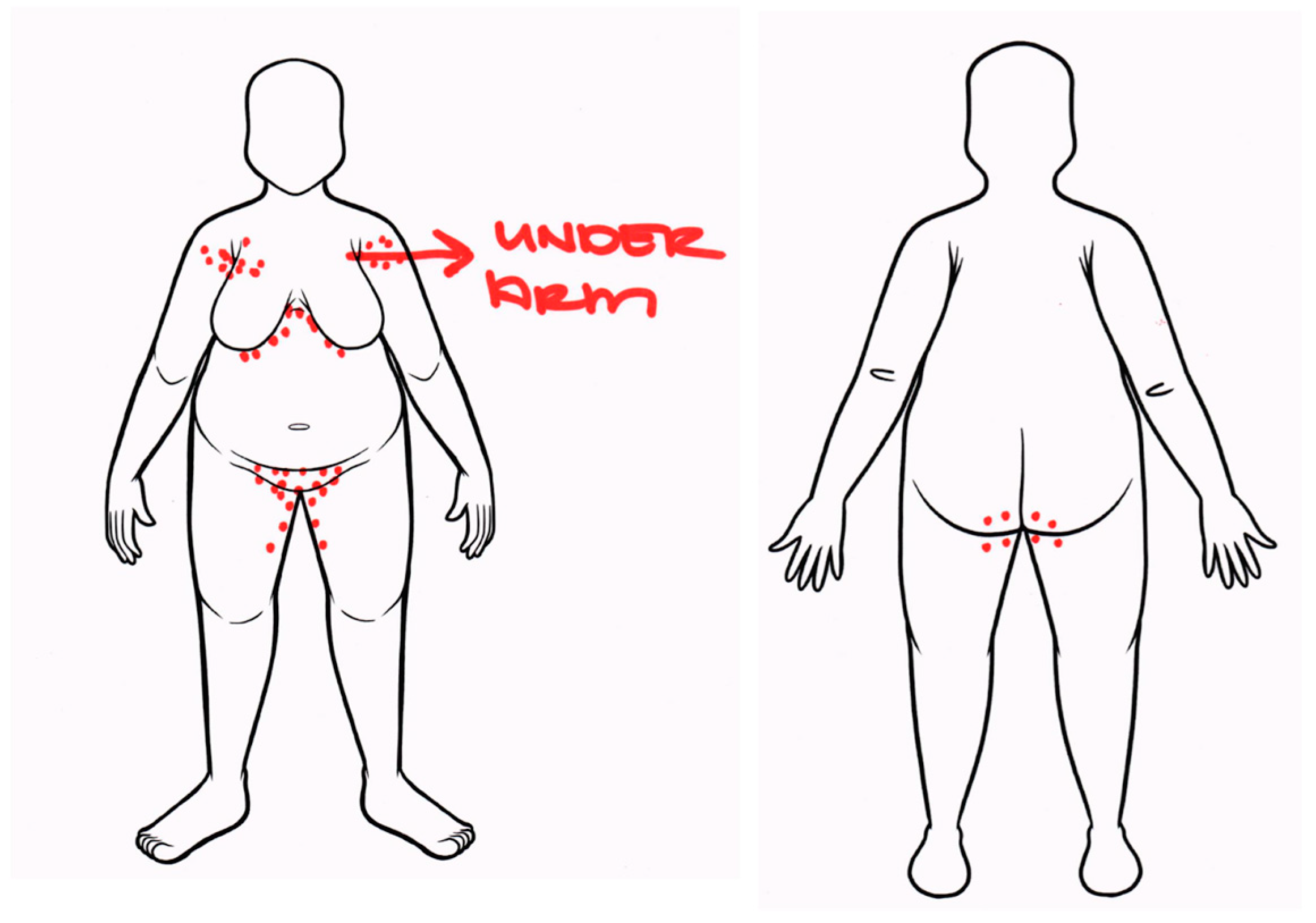
| Demographic | Interviews Count (%) n = 50 | Body Maps Count (%) n = 31 |
|---|---|---|
| Gender | ||
| Cisgender women Cisgender men Nonbinary | 46 (92%) 3 (6%) 1 (2%) | 28 (90%) 2 (7%) 1 (3%) |
| Race | ||
| White Black Latinx/Hispanic Biracial/Multiracial Middle Eastern/North African (MENA) Missing data | 24 (44%) 7 (14%) 8 (16%) 4 (8%) 1 (2%) 7 (14%) | 15 (48%) 3 (10%) 4 (17%) 3 (10%) 1 (3%) 4 (13%) |
| Country of Origin | ||
| USA North America Europe Central America Missing data | 42 (84%) 2 (4%) 2 (4%) 2 (4%) 2 (4%) | 27 (87%) 1 (3%) 2 (7%) 1 (3%) – |
Disclaimer/Publisher’s Note: The statements, opinions and data contained in all publications are solely those of the individual author(s) and contributor(s) and not of MDPI and/or the editor(s). MDPI and/or the editor(s) disclaim responsibility for any injury to people or property resulting from any ideas, methods, instructions or products referred to in the content. |
© 2024 by the authors. Licensee MDPI, Basel, Switzerland. This article is an open access article distributed under the terms and conditions of the Creative Commons Attribution (CC BY) license (https://creativecommons.org/licenses/by/4.0/).
Share and Cite
Ingraham, N.; Duong, K.; Hann, L.R. “It’s Like Having an Uncontrolled Situation”: Using Body Maps to Understand the Embodied Experiences of People with Hidradenitis Suppurativa, a Chronic Dermatological Condition. Soc. Sci. 2024, 13, 168. https://doi.org/10.3390/socsci13030168
Ingraham N, Duong K, Hann LR. “It’s Like Having an Uncontrolled Situation”: Using Body Maps to Understand the Embodied Experiences of People with Hidradenitis Suppurativa, a Chronic Dermatological Condition. Social Sciences. 2024; 13(3):168. https://doi.org/10.3390/socsci13030168
Chicago/Turabian StyleIngraham, Natalie, Kelly Duong, and Lena R. Hann. 2024. "“It’s Like Having an Uncontrolled Situation”: Using Body Maps to Understand the Embodied Experiences of People with Hidradenitis Suppurativa, a Chronic Dermatological Condition" Social Sciences 13, no. 3: 168. https://doi.org/10.3390/socsci13030168
APA StyleIngraham, N., Duong, K., & Hann, L. R. (2024). “It’s Like Having an Uncontrolled Situation”: Using Body Maps to Understand the Embodied Experiences of People with Hidradenitis Suppurativa, a Chronic Dermatological Condition. Social Sciences, 13(3), 168. https://doi.org/10.3390/socsci13030168






